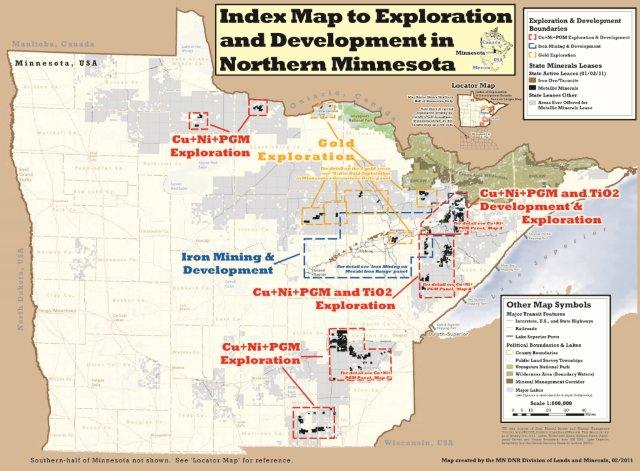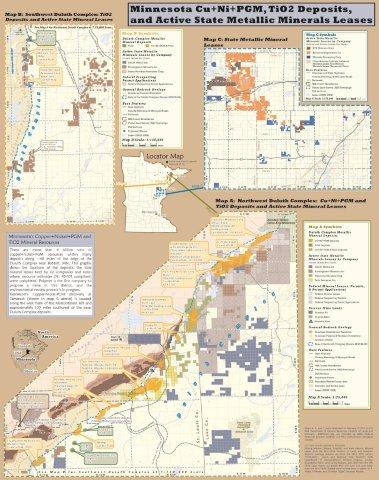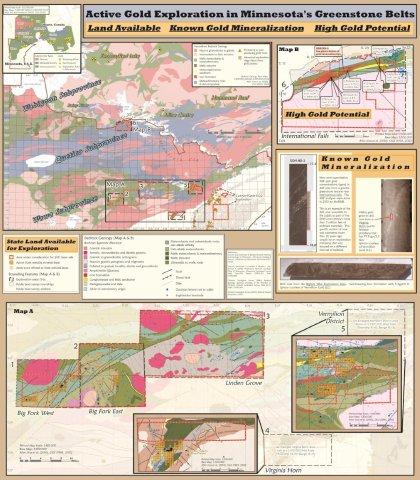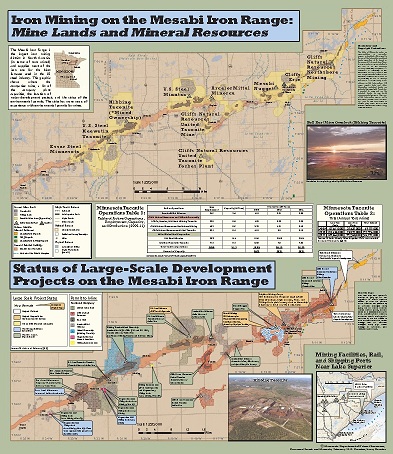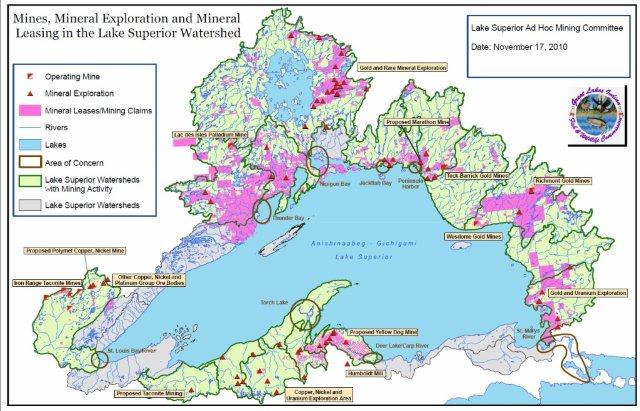Sulfide Mining District planned for Minnesota's Arrowhead Region
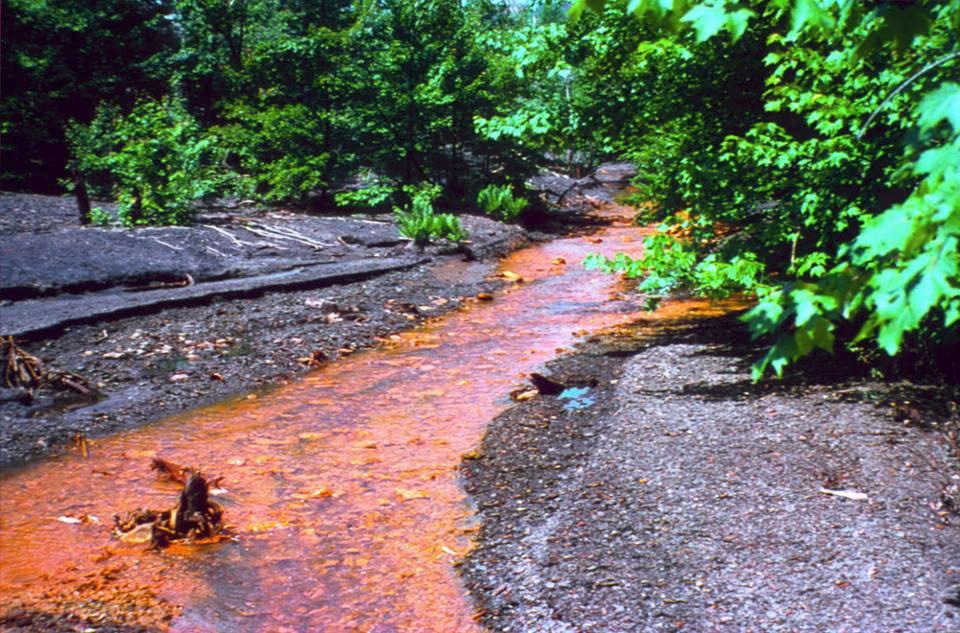
Acid Mine Drainage (AMD) source MPCA
Minnesota Mineral Exploration and Development
Metallic sulfide mining, an exceptionally destructive type of mining, is in the advanced stages of the permitting process in northeastern Minnesota. Concerned citizens and conservation organizations are closely following this emerging environmental and public health threat.
No sulfide mine has ever before been permitted in the State of Minnesota. However, in removing overburden at the Dunka taconite mine, a sulfide ore body was unearthed and stockpiled. The sulfide-containing rocks at the Dunka site have been polluting and discharging heavy metals into Bob Bay for decades. Bob Bay is part of Birch Lake, which drains into the Boundary Waters Canoe Area Wilderness (BWCAW). Despite attempts to mitigate the acid producing and metal leaching sulfides at the Dunka, a yearly variance from the federal “Clean Water Act” standards continues to be issued from the Minnesota Pollution Control Agency.
State mining laws regulating anything other than iron mining have never been tested and there is great concern that the existing laws are woefully inadequate. Pro-mining Iron Range legislators, along with politically appointed regulatory agency officials and the governor’s office, are applying political pressure on the agencies tasked with the environmental review of PolyMet’s NorthMet copper-sulfide project - the most advanced of Minnesota’s sulfide mine proposals to date, and currently in the late stages of permitting.
More than a dozen mining companies are in the advanced stages of exploration in areas across the state, including the very edges of the Boundary Waters Canoe Area Wilderness (BWCAW). Mining giants, such as Rio Tinto (Kennecott Minerals) and Teck-Cominco, are joined by a number of Canadian “junior” miners hoping to strike it rich at the expense of Minnesota’s real natural resource wealth – clean water and healthy forests. As with PolyMet’s project, most of the mineral leasing and exploration is on public land. If mining interests are successful, every watershed in Minnesota could be threatened with toxic sulfide mining.
Alarmingly, Franconia Minerals has been drilling for metals directly underneath Birch Lake. Another company, Duluth Metals, is rapidly advancing their mining plans by drilling, leasing, and mapping ore bodies that run next to the Kawishiwi River, which also flows into the Boundary Waters. Duluth Metals has optioned the adjacent Dunka property from Cleveland Cliffs (see above) and hopes to use the site to dump their mining wastes, adding even more pollution to Birch Lake. Duluth Metals has just completed an agreement to form a partnership with Antofagasta, a Chilean mining company. These companies are following the PolyMet environmental review process carefully, expecting that if PolyMet moves forward, their own chances of approval will be greatly increased. PolyMet optioned the shuttered LTV taconite processing plant from Cliffs Natural Resources for cash and 7% ownership by Cliffs, and is now seeking permits for one-third of the plant’s 100,000 tons-per-day capacity. It is expected that other mines would use PolyMet's excess processing capacity for their own ore, greatly reducing project costs and expediting the permit process.
Minnesota agencies have allowed ongoing pollution, at both the Dunka site and the former LTV plant and tailings basin, to continue in violation of federal water pollution law. The Department of Natural Resources (MDNR) and the Pollution Control Agency (MPCA), have continually shown that they are unable or unwilling to enforce existing laws pertaining to active and historic iron ore and taconite mines and will not recognize the cumulative, long-term effects of a sulfide mining rush throughout Minnesota. If current environmental oversight is inadequate for enforcing the iron mining industry, we can reasonably expect potentially catastrophic outcomes from any future sulfide mining projects. Documented cases of severe long-term sulfide mining disasters, in other parts of the US and the world, should raise a red warning flag to all Minnesotans concerned about the environmental and economic future of this state.
New Sulfide Mining District planned for Minnesota's Arrowhead Region
Click on image to see Index Map to Mineral Exploration and Development in Northern Minnesota
Source: State of Minnesota
Department of Natural Resources
Division of Lands and Minerals
Click on image to see Minnesota Cu+Ni+PGM, TiO2 Deposits, and Active State Metallic Minerals Leases
Source: State of Minnesota
Department of Natural Resources
Division of Lands and Minerals
Click on image to see Active Gold Exploration in Minnesota's Greenstone Belts
Source: State of Minnesota
Department of Natural Resources
Division of Lands and Minerals
Click on image to see Iron Mining on the Mesabi Iron Range / Status of Large-Scale Development Projects
Source: State of Minnesota
Department of Natural Resources
Division of Lands and Minerals
Click on image to see State of Minnesota mineral leasing
Source: State of Minnesota
Department of Natural Resources
Division of Lands and Minerals
Active and terminated minerals leases,
and areas ever offered for MM lease
(Status as of January 1, 2011.
Click Here to see larger image.
Mines, Mineral Exploration and Mineral Leasing in the Lake Superior Watershed
Source: Great Lakes Indian Fish & Wildlife Commission - GLIFWC
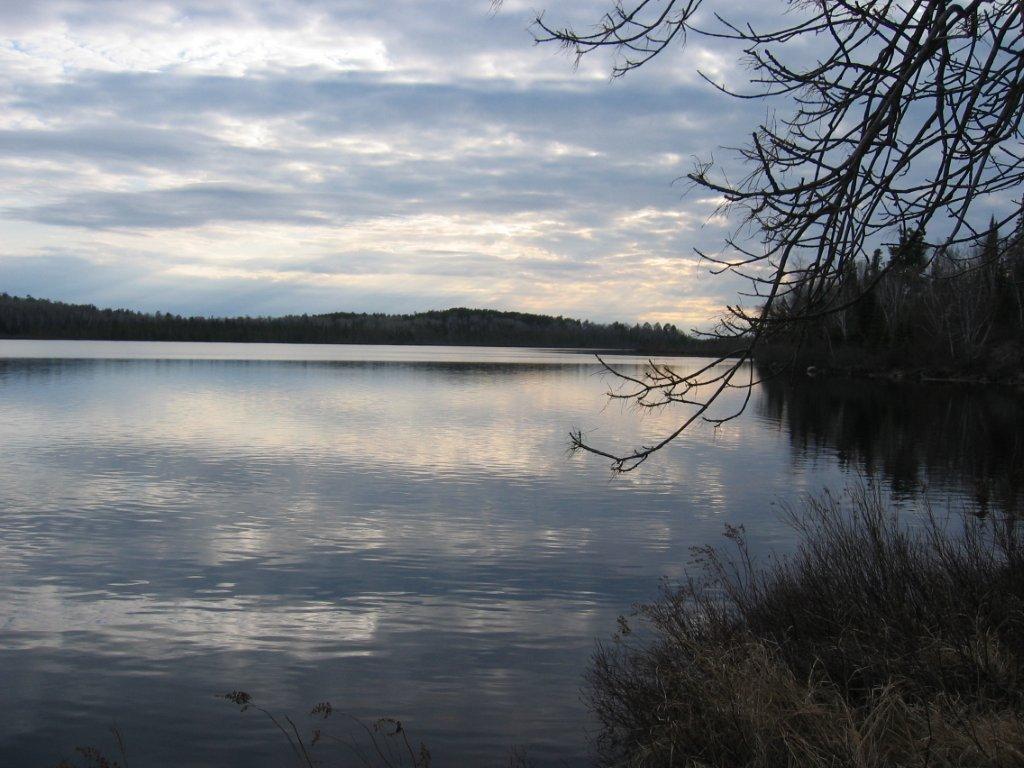
Image of Lake Vermilion, near Ely Minnesota.
Site of intense exploration and leasing for metallic sulfide minerals.



